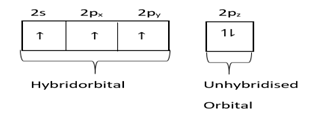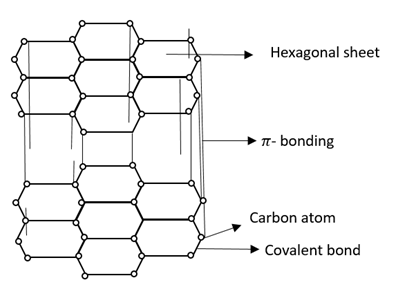
In graphite, electrons are:
(A) Localized on each carbon atom
(B) Spread out between the sheets
(C) localized on every third carbon atom
(D) present in antibonding orbital
Answer
221.4k+ views
Hint: Graphite is an allotrope of carbon element. When the same element is present in more than one form they are called allotropes.
Carbon is present in three forms in nature i.e. Diamond, Graphite and fullerene.
Complete step by step answer:
Carbon atom in graphite present in$s{p^2}$ hybridized state.
Electronic configuration of C is$ - 1{s^2}2{s^2}2p{x^1}2p{y^1}$
At ground state =

At excited state =

In graphite $1s$ and $2p$ orbital hybridize and form $s{p^2}$ hybridized orbital and one orbital remains hybridized.
Hybridized state=

Three hybrid orbits contain one electron each.
These electrons form a covalent bond with the hybrid orbital of other C-atoms.
Each carbon atom forms a covalent bond with another carbon atom. They form interlinked six membered rings of carbon atoms. The remaining half filled unhybridized $2{p^2}$orbital is used for$\pi $bonding. So that layers of carbon atoms i.e. graphite is formed.

Graphite has delocalized molecular orbital and delocalized electrons and is free to move in delocalized molecular orbital.
Therefore, electrons get spread between the sheets.
Therefore, from the above explanation, the correct option is B
Additional information:
Graphite is a good conductor of heat and electricity. The layer of carbon atoms in graphite can slide over another layer. So it is used in lubricants for reducing friction.
Note: Graphite forms hexagonal layers and these layers of carbon atom are held together by weak Van der Waals forces of attraction.
Carbon atoms have a unique property to link with itself called catenation. Due to this property allotropes of carbon form giant molecules.
Carbon is present in three forms in nature i.e. Diamond, Graphite and fullerene.
Complete step by step answer:
Carbon atom in graphite present in$s{p^2}$ hybridized state.
Electronic configuration of C is$ - 1{s^2}2{s^2}2p{x^1}2p{y^1}$
At ground state =

At excited state =

In graphite $1s$ and $2p$ orbital hybridize and form $s{p^2}$ hybridized orbital and one orbital remains hybridized.
Hybridized state=

Three hybrid orbits contain one electron each.
These electrons form a covalent bond with the hybrid orbital of other C-atoms.
Each carbon atom forms a covalent bond with another carbon atom. They form interlinked six membered rings of carbon atoms. The remaining half filled unhybridized $2{p^2}$orbital is used for$\pi $bonding. So that layers of carbon atoms i.e. graphite is formed.

Graphite has delocalized molecular orbital and delocalized electrons and is free to move in delocalized molecular orbital.
Therefore, electrons get spread between the sheets.
Therefore, from the above explanation, the correct option is B
Additional information:
Graphite is a good conductor of heat and electricity. The layer of carbon atoms in graphite can slide over another layer. So it is used in lubricants for reducing friction.
Note: Graphite forms hexagonal layers and these layers of carbon atom are held together by weak Van der Waals forces of attraction.
Carbon atoms have a unique property to link with itself called catenation. Due to this property allotropes of carbon form giant molecules.
Recently Updated Pages
Is PPh3 a strong ligand class 12 chemistry JEE_Main

JEE Main 2025-26 Mock Test: Organic Compounds Containing Nitrogen

JEE Main 2025-26 Organic Compounds Containing Nitrogen Mock Test

Full name of DDT is A 111trichloro22bispchlorophenyl class 12 chemistry JEE_Main

JEE Main Mock Test 2025-26: Purification & Characterisation of Organic Compounds

JEE Main Chemical Kinetics Mock Test 2025-26: Free Practice Online

Trending doubts
JEE Main 2026: Application Form Open, Exam Dates, Syllabus, Eligibility & Question Papers

Derivation of Equation of Trajectory Explained for Students

Hybridisation in Chemistry – Concept, Types & Applications

Understanding the Angle of Deviation in a Prism

How to Convert a Galvanometer into an Ammeter or Voltmeter

Degree of Dissociation: Meaning, Formula, Calculation & Uses

Other Pages
Solutions Class 12 Chemistry Chapter 1 CBSE Notes - 2025-26

NCERT Solutions For Class 12 Chemistry Chapter 1 Solutions - 2025-26

The D and F Block Elements Class 12 Chemistry Chapter 4 CBSE Notes - 2025-26

NCERT Solutions for Class 12 Chemistry Chapter Chapter 7 Alcohol Phenol and Ether

NCERT Solutions ForClass 12 Chemistry Chapter Chapter 8 Aldehydes Ketones And Carboxylic Acids

JEE Advanced Marks vs Ranks 2025: Understanding Category-wise Qualifying Marks and Previous Year Cut-offs




